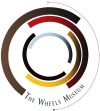University of Arizona’s Special Collections
Theresa Salazar
The Southwest’s existing transportation network traces its origin to the early migration corridors of the Native peoples and the exploratory routes of 16th century Spanish conquistadors. Later, as missionaries, traders, prospectors, soldiers, and settlers followed in their footsteps, the paths were transformed into rugged wagon trails. Along these routes staging areas and supply depots sprung up. The early settlements of Santa Fe, New Mexico (1609), San Diego, California (1769) and the Old Pueblo, Tucson, Arizona (1776), were central to the organization and development of life on the frontier.
Western lore has romanticized many of the historic trails. The Old Spanish Trail, the Old Gila Trail, and the Old Santa Fe Trail were three of the west’s most infamous trails. The Spanish Trail was the northermost route across the west going through Colorado and Utah. The Gila Trail was the southernmost route running through Arizona and New Mexico. The middle trail, the Santa Fe Trail, was the most direct route and it was chosen by the Santa Fe Railway Company for their transcontinental rail line.
When the stampede to the California gold fields started in 1848, it became evident to the nation that an improved transportation network was needed. The transcontinental railroad was planned, and railroad construction began a furious schedule of expansion. Most of this expansion was a highly competitive venture made by railroad companies into remote areas of little settlement and mere promise of economic return. The gamble paid off after towns and cities located along the rail lines and the Southwest became populated.
Two rail companies, the Atchinson, Topeka and Santa Fe (popularly known as the Santa Fe) and the Southern Pacific Company, were instrumental in building the rail transportation network throughout the Southwest.
The Santa Fe Railroad, after its infrastructure was in place, began to promote the settlement and economic development of the region. In the late 1800’s, in order to attract more passenger traffic to its line, the company started an aggressive campaign to promote tourism. This meant building hotels and restaurants for the comfort of their passengers. The company also commissioned ethnographers, artists and photographers to depict the Southwest’s scenic splendor and its unique Indian culture to entice travelers to visit and explore the area. The promotional slogan “Santa Fe Southwest” was coined in their advertisements. By 1910 they had an exclusive connection to the Grand Canyon, the greatest scenic attraction in the Southwest, and they used it as a major part of their promotional campaign.
The Santa Fe became more than a railroad company. It had wholly-owned and partially-owned subsidiaries in real estate, petroleum, lumber, hotels, restaurants, and car-ferry and stage-highway road services. Its most notable partner in the hotel and restaurant business was the Fred Harvey Company. The story of how Fred Harvey and his “Harvey Girls” helped civilize the west is a frontier legend. The Harvey Company went on to found an empire of eating establishments and hotels linked to the Santa Fe Railroad.
Just as the Santa Fe had commissioned artists to capture the mystique of the region, the Fred Harvey Company began its own collection of Indian artifacts and handmade crafts. The company, to some extent, imitated museum collectors, and by 1902 they had a permanent collection of Native arts and crafts displayed in the Indian Building in Albuquerque, New Mexico. That display was followed a few years later by one at the Hopi House, next to the Grand Canyon’s famous hotel, the El Tovar.
Some of the artists who worked for the Santa Fe were Maynard Dixon; Louis Akin, who toured Arizona in 1903; Thomas Moran; William R. Leigh, known as the “sagebrush Rembrandt”; and Taos artist E. Irving Couse. After purchasing the artist’s works, the railroad then proceeded to reproduce them on its promotional literature. Postcards, dining menus, picture books, and brochures were elaborately reproduced. Our selection of dining car menus highlights some of these artists.
Not to be outdone, the Southern Pacific Company had its own promotional campaign. They coined the slogans “Golden Empire” amd “Sunset Route” and used them on their train time schedules and brochures. The Southern Pacific Company offered cross country service from New York to New Orleans via steamship, with train connections on to San Francisco and Portland. The earliest Southern Pacific rail line closely followed the Old Gila Trail through El Paso, Texas and Yuma, Arizona. Our selection of train time schedules from both companies demonstrate the level of promotional competition and artistic flair they encouraged.
